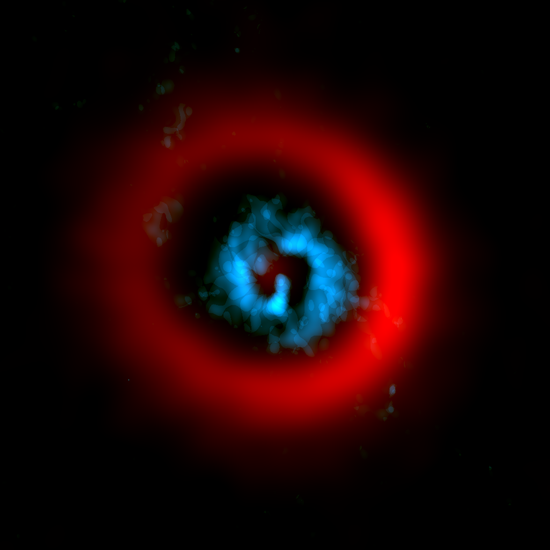研究成果藝廊
Spirals inside a dust gap of a young star forming disk
圖片來源: ALMA (ESO/NAOJ/NRAO)/ Tang et al.

ALMA image of the dust ring (red) and gaseous spirals (blue) of the circumstellar disk AB Aurigae.
Sharp ALMA images of the circumstellar disk around the young star AB Aurigae reveal gaseous spiral arms inside a wide dust gap, likely providing a clue on planet formation.
Planets form within disks composed of dust grains and gas. Planets can gather dust grains from their orbits, resulting in dust gaps or cavities, and can also cause spiral waves within the parental disks based on theoretical predictions. In order to understand where and when planets can form at early stages, ALMA’s capability of seeing disk material with high resolution can reveal smoking-gun evidence of infant planets hidden in disks.
Both dust gaps and spirals have been seen separately in a handful of disks. The new ALMA images of AB Aurigae clearly reveal gas spirals inside a wide dust gap. These first reported gas spirals within a dust gap might indicate that there are at least 2 planets within this system. One planet at a distance of 80 astronomical units (au; the distance between the Sun and Earth) from the star is required to create the sharp dust ring. An additional planet at a distance of 30 au or closer from the star is required to produce such spirals.
These gas spirals further provide an additional dimension to our understanding of planet- disk interaction. Spirals previously seen in the near infrared image appear at the inner edge of the newly detected gas spirals. This can happen when the gas spirals are puffed up and thus scatter more stellar light at locations closer to the star. The kinematics of gas within the spirals mostly follows the disk rotation. It is only at the putative planet location at a distance of 30 au from the star that gas moves at higher velocities, suggesting streaming motions near the planet.